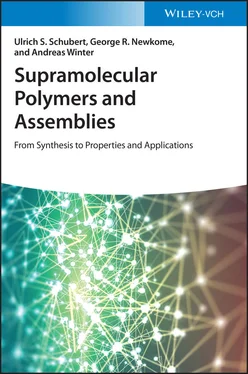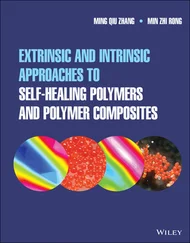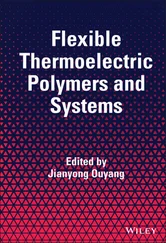5 Chapter 5Figure 5.1 Illustration of the interactions between two idealized p atoms as a function of their orientation – two “attractive” geometries and the “repulsive” face‐to‐face‐type geometry are shown. Source: Hunter and Sanders [4]; © 1990 American Chemical Society.Figure 5.2 Schematic representation of the hexa‐ peri ‐substituted hexabenzocoronenes 1along with the proposed stacking mode. The polarized optical microscopy (POM) (a) and atomic‐force microscopy (AFM) and (b) images of drop‐casted fibers of 1eare also shown. Source: Kastler et al. [12]. Figure reproduced with kind permission; © 2005 American Chemical Society.Figure 5.3 Schematic representation of the amphiphilic HBCs 2and their supramolecular polymerization into tubular structures. Source: Modified from Hill et al. [13].Figure 5.4 Schematic representation of the self‐assembly of a discotic amphiphile in aqueous medium. Source: Aida [15], © 2020 John Wiley and Sons.Figure 5.5 Schematic representation of 3,5‐diphenylisoxazoles featuring a local dipole moment and a planar structure. Source: Haino et al. [17], © 2008 Royal Society of Chemistry.Figure 5.6 Schematic representation of the C 3‐symmetric diphenylisoxazoles 3along with the proposed packing mode. FE‐SEM images of the fibers obtained from 3a(a) and 3b(b). Source: Haino et al. [17]. Figure reproduced with kind permission; © 2008 The Royal Chemical Society.Figure 5.7 (a) Schematic representation of the basic diketopyrrolopyrrole structures 4. (b) Schematic representation of the donor–acceptor–donor molecules 5, which assembled due to π–π stacking interactions of their outer electron‐rich chromophores. Source: Lee et al. [18], © 2011 John Wiley and Sons.Figure 5.8 Schematic representation of representative core‐unsubstituted PBI dyes ( 6– 10).Figure 5.9 Schematic representation of representative bay‐substituted PBI dyes ( 11and 12).Figure 5.10 (a) Representation of the color tunability of the emission of 6ain solution, the red emission from a spin‐coated film of 6ais shown on the very right. (b) POM image of the LC phase of 6a. Source: Chen et al. [25]. Figure reproduced with kind permission; © 2007 Wiley‐VCH.Figure 5.11 (a) Schematic representation of the proposed columnar stacking mode of PBI molecules. (b) Plot of the standard Gibbs free energy (Δ G 0) for an isodesmic aggregation process vs. the solvent polarity parameter [ E T(30)] for 6a(●x025CF;) and 6c(▲x025B2;). Source: Chen et al. [26], © 2012 The Royal Chemical Society.Figure 5.12 Schematic representation of the equilibrium between 6dand its aggregates in solution. At low a concentration and/or a high temperature, dimers of M ‐type helicity were preferred; whereas, at high concentrations and/or low temperatures, extended polymeric stacks of P ‐configuration were formed. Source: Dehm et al. [31], © 2007 American Chemical Society.Figure 5.13 Schematic representation of the solvent‐dependent self‐assembly/disassembly behavior observed for a binary mixture of 7and an OPV derivative. Source: van Herrikhuyzen et al. [32], © 2004 American Chemical Society.Figure 5.14 Scanning electron microscopy images of the nanobelts and nanoparticles obtained from the self‐assembly of 9aand 10b, respectively. Source: Balakrishnan et al. [34]. Figure reproduced with kind permission; © 2006 American Chemical Society.Figure 5.15 Schematic representation of the two different stacking modes: Longitudinally displaced J‐type stacking of 11a(a) and rotationally displaced cofacial stacking of 11c(b). Source: Chen et al. [37]. © 2007 John Wiley and Sons.Figure 5.16 Schematic representation of amphiphilic squaramide dyes which gave supramolecular polymers due to dipolar π–π stacking interactions. Source: Bujosa et al. [49], © 2020 The Royal Chemical Society.Figure 5.17 Schematic representation of the boron‐centered triangulene 13that self‐assembled into a columnar LC phase. Source: Kushida et al. [55]. © 2015 John Wiley and Sons.Figure 5.18 (a) Schematic representation of the different packing modes of bowl‐shaped molecules (from the non‐columnar type‐C assemblies only one representative example is shown). (b) Schematic representation of the P‐centered triangulenes 14. Source: Yamamura et al. [56], © 2016 American Chemical Society.Figure 5.19 Schematic representation of the competition between the homo‐ and hetero‐type stacking of donor–acceptor‐type molecules driven by π–π and charge–transfer stacking forces, respectively. Source: Modified from Han et al. [59].Figure 5.20 Schematic representation of the synthesis of an amphiphilic D–A‐type foldamer and its self‐assembly into a 1D nanostack. Source: Jalani et al. [64], © 2013 Royal Society of Chemistry.Figure 5.21 Schematic representation of the amphiphilic donor–acceptor molecule 17that could assemble into nanosheets or vesicles depending on its conformation. Source: Jalani et al. [65]. Licenced under CC BY 3.0.Figure 5.22 Schematic representation of the various types of molecular tweezers/guest recognition motifs. (a) DAD‐ and ADA‐type assemblies, (b) DADA‐ and ADADA‐type assemblies and (c) self‐complementary and head‐to‐tail dimerization. Source: Han et al. [59], © 2018 The Royal Chemical Society.Figure 5.23 Schematic representation of the metal‐induced activation (a) and deactivation (b) of molecular tweezers according to Petitjean et al. [71].Figure 5.24 Schematic representation of the formation of a π‐electron ion pair via ion metathesis. Source: Haketa and Maeda [72], © 2017 Royal Society of Chemistry.Figure 5.25 Schematic representation of the three different self‐assembly modes of π‐electron ion pairs: charge‐by‐charge (a), charge segregated (b), and intermediate stacking (c). Source: Dong and Maeda [74].Figure 5.26 Schematic representation of the formation of a π ‐electron anion via the supramolecular complexation of a (halide) ion by a planar anion receptor. (a) cartoon representation and (b) at the example of 18. Source: Dong and Maeda [74], © 2013 Royal Society of Chemistry.Figure 5.27 Schematic representation of the formation of π‐electron anions by deprotonation of OH‐groups.Figure 5.28 Schematic representation of the π‐electron ion pairs, based on the cycloheptatrienyl (Ch +) cation and cyclopentadienyl anions ( 21 −). The representations show the packing mode of [Ch][ 21b] in the solid state (three different views are depicted). Source: Bando et al. [85], © 2016 John Wiley and Sons.Figure 5.29 (a) Schematic representation of the TATA +cation 22and of the receptor–anion complex [ 23⋅⋅⋅Cl] −. (b) POM images, XRD patterns (at 101 °C) and proposed packing modes (from left to right) of the ion pairs [ 22][ 23⋅⋅⋅Cl] (a). Source: Haketa et al. [86]. Figure reproduced with kind permission; © 2010 Wiley‐VCHFigure 5.30 Schematic representation of the square‐planar Pt(II) complexes 24. The XRD pattern and the proposed packing mode for the ion‐pairing assembly of 24band [ 23⋅⋅⋅Cl] −is also shown. Source: Sekiya et al. [89], © 2014 Royal Society of Chemistry.Figure 5.31 Schematic representation of the molecular tweezers 25and their reversible self‐assembly of 25ainto a linear supramolecular polymer. Source: Kim et al. [90], © 2012 American Chemical Society.Figure 5.32 Schematic representation of the pH‐switchable molecular tweezers 26that were used for the assembly of a packed liposome bilayer with 1,2‐dioctadecanoyl‐ sn ‐glycero‐3‐phosphocholine (DSPC) and N ‐(carbonyl‐methoxypolyethyleneglycol‐2000)‐1,2‐distearoyl‐ sn ‐glycero‐3‐phosphoethanolamine (DSPE‐PEG 2000). The packed liposome bilayer collapsed upon acidification. Source: Viricel et al. [94].© 2015 John Wiley and Sons.Figure 5.33 Schematic representation of the molecular tweezers 27containing two positively‐charged organoplatinum(II) pincers. Source: Tanaka et al. [95], © 2013 John Wiley and Sons.Figure 5.34 Schematic representation of the reversible supramolecular polymerization of 28. Source: Tian et al. [96], © 2014 John Wiley and Sons.Figure 5.35 Schematic representation of the complementary homoditopic monomers 29and 30and their supramolecular polymerization in a DADA‐type fashion. The evolution of the specific viscosity as a function of the monomer concentration is also shown. Source: Tian et al. [97], © 2016 American Chemical Society.Figure 5.36 Schematic representation of the porphyrin‐based molecular tweezers 31and of the self‐complementary dimerization of 31a. Source: Haino et al. [68], © 2006 American Chemical Society.Figure 5.37 Schematic representation of the supramolecular polymerization of 32. Source: Modified from Haino et al. [99].Figure 5.38 Schematic representation of the heteroditopic monomers 33and of the supramolecular polymerization of 33a. The specific viscosity of 33ain CHCl 3(white circles) and toluene (black circles) at 293 K is also depicted. Source: Haino et al. [100], © 2012 John Wiley and Sons.Figure 5.39 Schematic representation of the bis‐pyridine derivative 34that was used for the formation of a supramolecular polymer network in combination with 33b. A picture of the free‐standing polymer film of this material is also shown. Source: Hager et al. [102]. Figure reproduced with kind permission; © 2015 Wiley‐VCH.Figure 5.40 Schematic representation of the calix[4]pyrroles 35that adopted a 1,3‐alternate conformation, which could accommodate two guest molecules via CT interactions. The conformation of 35could be switched reversibly by adding chloride anions. Source: Nielsen et al. [107], © 2004 American Chemical Society.Figure 5.41 Schematic representation of the supramolecular polymers derived from 35and 36. A representative SEM image of the fiber‐like assemblies also shown. The polymers could be disassembled in the presence of competitive guest molecules or anions. Source: Park et al. [110]. Figure reproduced by kind permission; © 2011 National Academy of Science.Figure 5.42 Schematic representation of the supramolecular 2 : 1 complex formed by γ‐CD and C 60in water. Source: Based on Andersson et al. [114].Figure 5.43 Schematic representation of a molecular tweezers on the basis of a bis‐calix[5]arene ( 38) and its encapsulation of a C 60guest in the cavity. Source: Based on Haino et al. [116].Figure 5.44 Schematic representation of the bis‐exTTF‐based molecular tweezers 39and its solvent‐dependent interaction with C 60. Source: Pérez et al. [118], © American Chemical Society.Figure 5.45 Schematic representation of the heteroditopic monomer 40and of the corresponding supramolecular CT polymer ( 40) n. The AFM images of ( 40) ndeposited onto a mica surface are also shown (left: 2D image, 277 nm × 277 nm; right: 3D image, 80 × 65 nm). Source: Fernández et al. [119], Figure reproduced with kind permission; © 2008 Wiley‐VCH.Figure 5.46 Schematic representation of the preorganized exTTF‐based receptor 41and the analogous AB‐type monomer 42. The MALDI‐TOF mass spectrum of ( 42) nis also depicted. Source: Isla et al. [120], © 2014 John Wiley and Sons.Figure 5.47 Schematic representation of the formation of a supramolecular hyperbranched polymer starting from an AB 2‐type monomer. Source: Fernández et al. [121], © 2008 American Chemical Society.
Читать дальше












